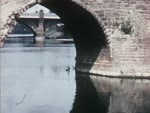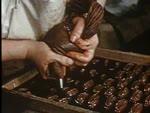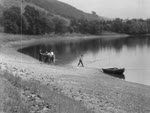OCHILTREE TILE WORKS
Full length video
Please read Understanding catalogue records for help interpreting this information and Using footage for more information about accessing this film.
Title: OCHILTREE TILE WORKS
Reference number: 0948
Date: 1951
Production company: SEFA (Ayrshire Group)
Sound: silent
Original format: 16mm
Colour: bw
Fiction: non-fiction
Running time: 10 mins
Description:
The manufacturing processes involved in producing clay tiles.
Commended at the Scottish Amateur Film Festival 1951
Credits:
p. James B. Johnstone and John Nimmo.
Commended at the Scottish Amateur Film Festival 1951
Shotlist: Credits (.23); General views of the exterior of the tile works (.30); Shots of tiles stacked up in yard (.34); Clay deposits near Ochiltree, Ayrshire, are suitable for making drainage tiles. General views of men digging up slabs of clay and loading them onto wheelbarrow, which is then taken away along a plank (1.28); A skip is sent down on rails to the workforce from a building about 100 yards away. It is filled with clay and pulled back up by rope (2.02); Lime is mixed with the clay to make it more plastic. Lime is shovelled onto clay which is put into mixer (2.25); After mixing the clay is ready to be moulded. Pieces of clay are fed into a machine (2.35); The clay is shaped by being fed through a template. One man marks out a template, then it is attached to the machine and the clay is forced through, forming tubular lengths (3.01); More shots of loading clay into machine and then at the other end as the lengths of clay are passed along conveyor where it is then sliced into short lengths (3.41); The shaped lengths are stacked for drying. Men use three-pronged fork-like instrument to pick up the lengths and stack them onto shelves (4.27); Shot of the wall of the yard, lined with shelves of clay tubes (4.35); The dried lengths are hardened by firing in a kiln. Kiln is loaded with barrowfuls of dried pipes (5.20); The door is bricked up and sealed with a layer of cement and mortar (6.21); The fires are stoked (6.41); Shots of kiln with all chimneys belching out smoke (6.52); After three days the wicket or door is opened. The mortar is chipped away and the bricks pulled out (7.32); The tiles are removed when cold. Man loads barrow with tiles from the kiln and stacks them up in the yard (8.05); A lorry, marked on the tailboard with "Drain with Ochiltree Tiles", is loaded with tiles (8.10); Long shot of the works as lorry pulls out of the gate with its load (8.30); The End (8.34)






